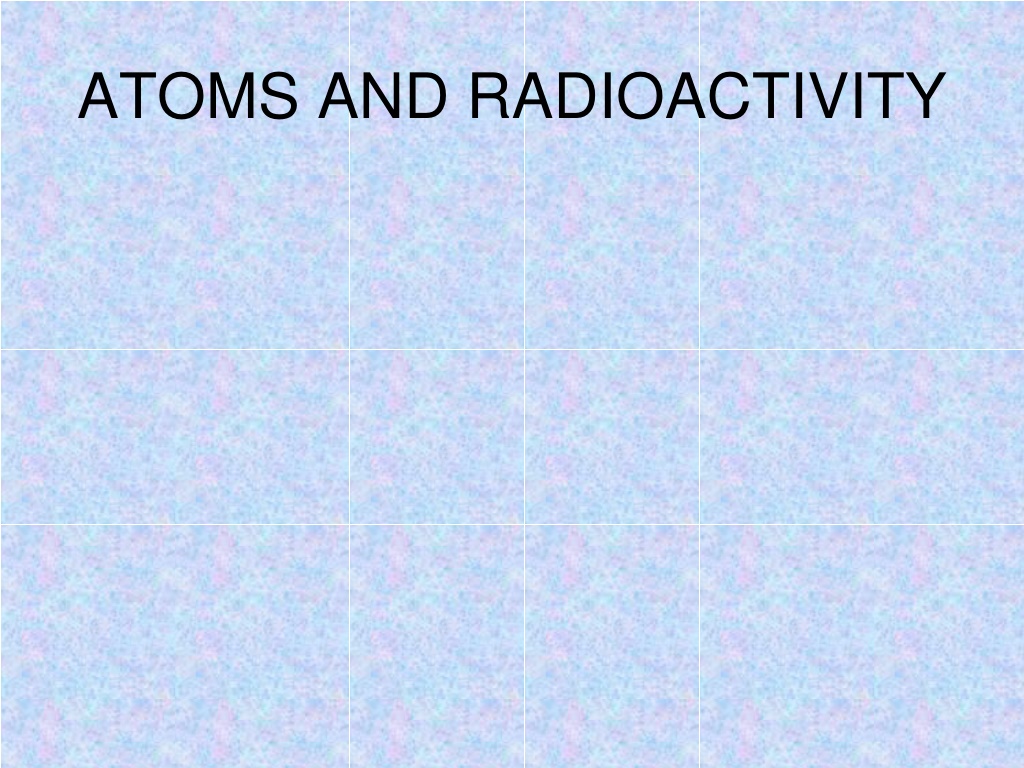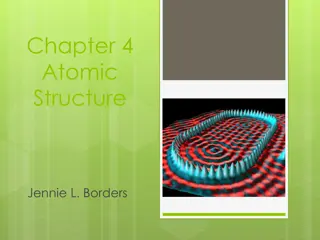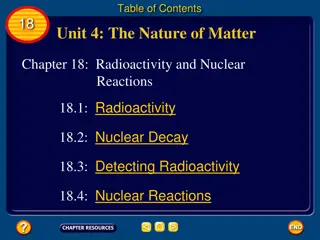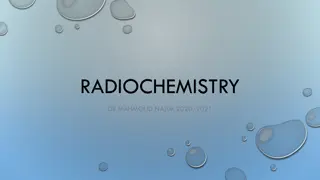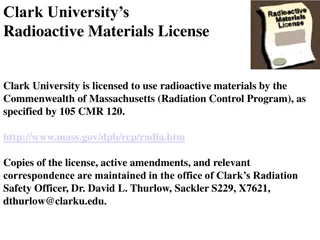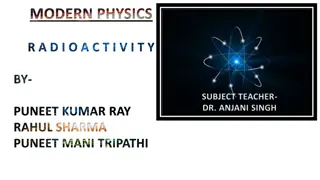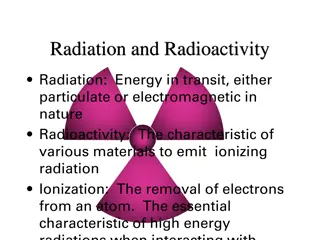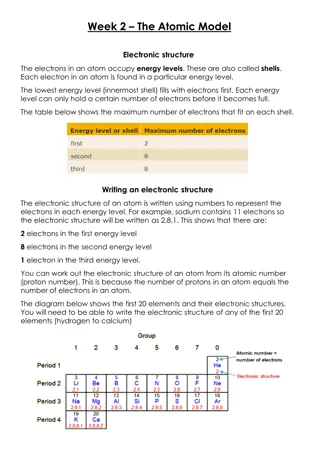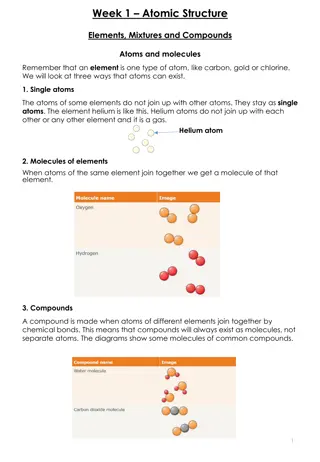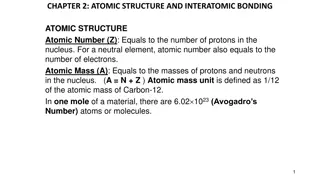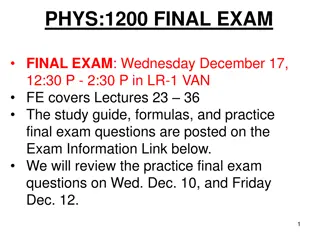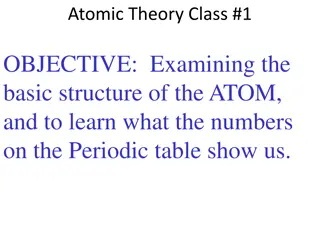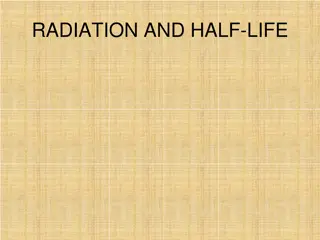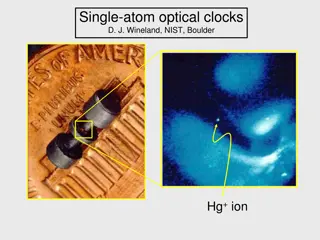Atomic Structure and Radioactivity
Explore the composition of atoms with protons, neutrons, and electrons, and learn about isotopes, nuclear notation, and the properties of subatomic particles. Understand radioactivity, including alpha, beta, and gamma radiation, and their impact on atomic and mass numbers. Discover the significance of isotopes in elements like hydrogen and the basics of balanced nuclear equations.
Download Presentation

Please find below an Image/Link to download the presentation.
The content on the website is provided AS IS for your information and personal use only. It may not be sold, licensed, or shared on other websites without obtaining consent from the author.If you encounter any issues during the download, it is possible that the publisher has removed the file from their server.
You are allowed to download the files provided on this website for personal or commercial use, subject to the condition that they are used lawfully. All files are the property of their respective owners.
The content on the website is provided AS IS for your information and personal use only. It may not be sold, licensed, or shared on other websites without obtaining consent from the author.
E N D
Presentation Transcript
Specification Radioactivity and particles Radioactivity describe the structure of an atom in terms of protons, neutrons and electrons and use symbols such as 146C to describe particular nuclei understand the terms atomic (proton) number, mass (nucleon) number and isotope understand that alpha and beta particles and gamma rays are ionising radiations emitted from unstable nuclei in a random process describe the nature of alpha and beta particles and gamma rays and recall that they may be distinguished in terms of penetrating power describe the effects on the atomic and mass numbers of a nucleus of the emission of each of the three main types of radiation understand how to complete balanced nuclear equations
Atomic structure An atom consists of a small central nucleus composed of protons and neutrons surrounded by electrons. An atom will always have the same number of electrons as protons. A Lithium atom protons neutrons electrons
Atomic and mass number The atomic number (or proton number) of an atom is equal to the number of protons in its nucleus. protons = 3 neutrons = 4 electrons = 3 This Lithium atom has: The mass number (or nucleon number) of an atom is equal to the number of protons plus neutrons in its nucleus. atomic number = 3 mass number = 7
Properties of protons, neutrons and electrons Position in the atom Relative mass Relative electric charge 1 1 + 1 nucleus PROTON 1 1 0 NEUTRON nucleus outside nucleus 0.005 0.005 - 1 ELECTRON
Nuclear notation An isotope of carbon consists of 6 protons and 8 neutrons. This can be written as: carbon 14 Number of protons PLUS neutrons (Mass number) OR: 14 C Chemical symbol Number of protons (Atomic number) 6
Isotopes The atoms of an element always have the same number of protons. Isotopes are atoms of the same element with different numbers of neutrons. The three isotopes of hydrogen neutrons hydrogen 1 hydrogen 2 (deuterium) hydrogen 3 (tritium) Note: The number after hydrogen is the mass number of the isotope.
Question 1 An isotope of uranium (chemical symbol U) consists of 92 protons and 143 neutrons. Give the two different ways of notating this isotope. The mass number of the Uranium isotope: = 92 + 143 = 235 235 U uranium 235 AND 92
Question 2 Determine the number of protons and neutrons in the isotopes notated below: (b) (a) 60 13 protons = 7 neutrons = 6 p = 27 n = 33 Co N 27 7 (d) (c) 239 p = 94 n = 145 197 p = 79 n = 118 Pu Au 94 79 Note: Apart from the smallest atoms, most nuclei have more neutrons than protons.
Ionisation Ionisation occurs when an atom loses or gains one or more electrons. Lithium atom (uncharged) When an atom loses electrons it becomes a positive ion. When an atom gains electrons it becomes a negative ion. Lithium ion (positively charged)
Radioactivity and Ionising Radiation The nuclei of some isotopes are unstable and when they decay they give of radiation that causes ionisation. This phenomena is called radioactivity and the radiation produced is called ionising radiation Radioactivity is a random process. When a particular nucleus decays cannot be predicted. Henri Becquerel discovered radioactivity in 1896
Alpha, beta and gamma radiation An alpha particle consists of two protons and two neutrons. It is strongly ionising. A beta particle is a high speed electron. It is produced when a neutron has decays into an electron and proton. It is moderately ionising. Gamma rays are very high frequency electromagnetic waves. They are produced when an unstable nucleus loses energy.. They are weakly ionising.
The penetrating power of alpha, beta and gamma radiation Paper or a few cm of air stops alpha particles 1cm or 1m of air of aluminium stops beta particles Several cm of lead or 1m of concrete is needed to stop gamma rays
Deflection by magnetic fields Alpha and beta particles are deflected in opposite directions due to their opposite charges. S Due to their much larger mass alpha particles are deflected far less than beta. Gamma rays are not deflected because they are not charged. Magnetic south pole placed behind the rays
Deflection by electric fields Alpha and beta particles are deflected in opposite directions due to their opposite charges. - - - Due to their much larger mass alpha particles are deflected far less than beta. Gamma rays are not deflected because they are not charged. + + + Electric field produced by positively and negatively charged plates
Choose appropriate words to fill in the gaps below: Atoms consist of a very small _______, containing protons and neutrons, surrounded by _______. Atoms of the same element will always have the same number of _______ but different ________ of the same element will have different numbers of _________. The atoms of some substances are unstable and _________. They may give off alpha or ______ particles or gamma rays. Gamma rays are the most penetrating type of radiation, _____ is the least. WORD SELECTION: alpha beta protons electrons neutrons isotopes radioactive nucleus
Choose appropriate words to fill in the gaps below: Atoms consist of a very small _______, containing protons and neutrons, surrounded by _______. Atoms of the same element will always have the same number of _______ but different ________ of the same element will have different numbers of _________. neutrons nucleus electrons protons isotopes The atoms of some substances are unstable and _________. They may give off alpha or ______ particles or gamma rays. beta radioactive Gamma rays are the most penetrating type of radiation, _____ is the least. alpha WORD SELECTION: alpha beta protons electrons neutrons isotopes radioactive nucleus
Alpha decay Alpha particles consist of two protons plus two neutrons. They are emitted by some of the isotopes of the heaviest elements.
Example: The decay of Uranium 238 238 4 234 + U Th 92 2 90 Uranium 238 decays to Thorium 234 plus an alpha particle. Notes: 1. The mass and atomic numbers must balance on each side of the equation: (238 = 234 + 4 AND 92 = 90 +2) 4 2. The alpha particle can also be notated as: He 2
Question Show the equation for Plutonium 239 (Pu) decaying by alpha emission to Uranium (atomic number 92). 239 4 235 + Pu U 94 2 92
Beta decay Beta particles consist of high speed electrons. They are emitted by isotopes that have too many neutrons. One of these neutrons decays into a proton and an electron. The proton remains in the nucleus but the electron is emitted as the beta particle.
Example: The decay of Carbon 14 14 14 0 - + C N 6 -1 7 Carbon 14 decays to Nitrogen 14 plus a beta particle. Notes: 1. The beta particle, being negatively charged, has an effective atomic number of minus one. 0 2. The beta particle can also be notated as: e -1
Question Show the equation for Sodium 25 (Na), atomic number 11, decaying by beta emission to Magnesium (Mg).
Question Show the equation for Sodium 25 (Na), atomic number 11, decaying by beta emission to Magnesium (Mg). 0 25 25 - + Na Mg -1 12 11
Gamma decay Gamma decay is the emission of electromagnetic radiation from an unstable nucleus Gamma radiation often occurs after a nucleus has emitted an alpha or beta particle. Example: Cobalt 60 0 60 60 + Co Co 27 27 0 Cobalt 60 with excess ENERGY decays to Cobalt 60 with less ENERGYplus gamma radiation.
Changing elements Both alpha and beta decay cause the an isotope to change atomic number and therefore element. Alpha decay also causes a change in mass number. Decay type Atomic number Mass number alpha DOWN by 2 DOWN by 4 beta UP by 1 NO CHANGE gamma NO CHANGE NO CHANGE
Complete the decay equations below: 0 59 59 - + Fe Co (a) -1 27 26 224 4 220 + Ra Rn (b) 88 2 86 0 16 16 - + N O (c) 7 -1 8
Write equations showing how Lead 202 could decay into Gold. (This cannot happen in reality!) Element Sym Z 202 198 4 + Pb Hg Platinum Pt 78 82 80 2 Gold Au 79 198 194 4 Mercury Hg 80 + Hg Pt 80 78 2 Thallium Tl 81 194 194 0 Lead Pb 82 - Pt Au + Bismuth Bi 83 78 79 -1 There are other correct solutions
Choose appropriate words to fill in the gaps below: When an unstable nucleus emits an alpha particle its atomic number falls by _______ and its mass number by ______. Beta particles are emitted by nuclei with too many ________. In this case the atomic number increases by ______ while the ________ number remains unchanged. Gamma rays consist of ______________ radiation that is emitted from a nucleus when it loses ________, often after undergoing alpha or beta decay. WORD SELECTION: four one energy two neutrons mass electromagnetic
Choose appropriate words to fill in the gaps below: When an unstable nucleus emits an alpha particle its atomic number falls by _______ and its mass number by ______. two four Beta particles are emitted by nuclei with too many ________. In this case the atomic number increases by ______ while the ________ number remains unchanged. mass neutrons one Gamma rays consist of ______________ radiation that is emitted from a nucleus when it loses ________, often after undergoing alpha or beta decay. electromagnetic energy WORD SELECTION: four one energy two neutrons mass electromagnetic
